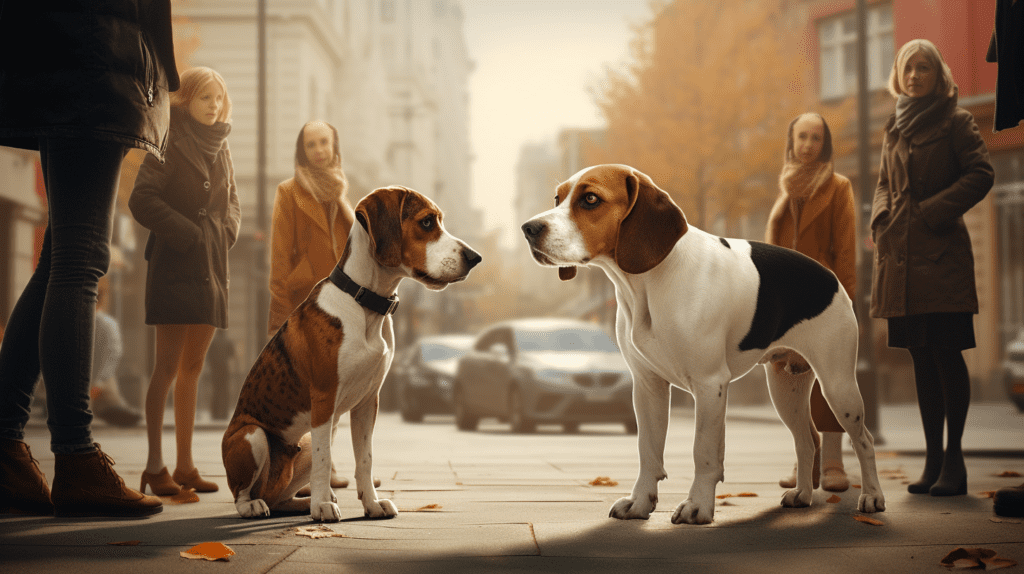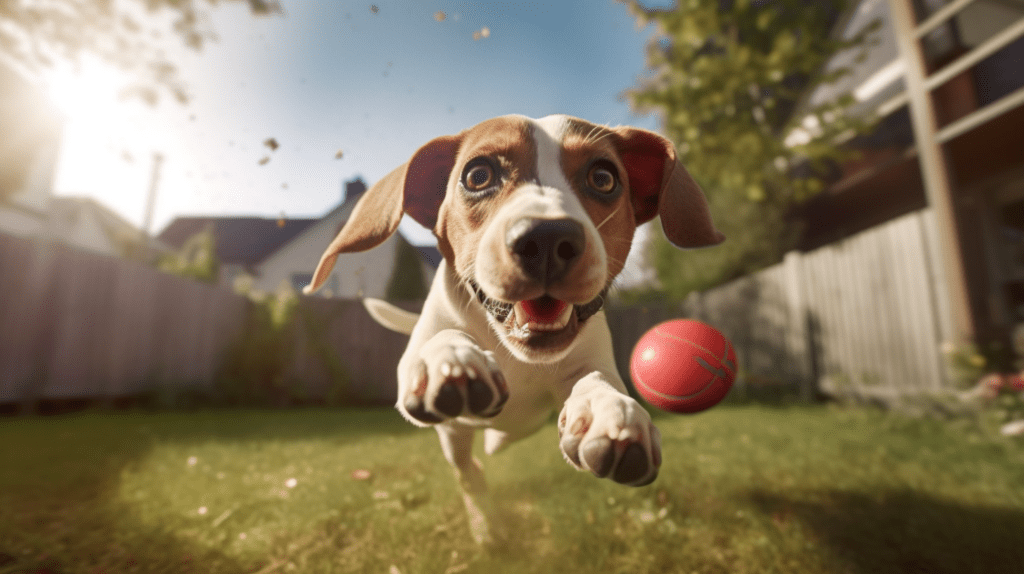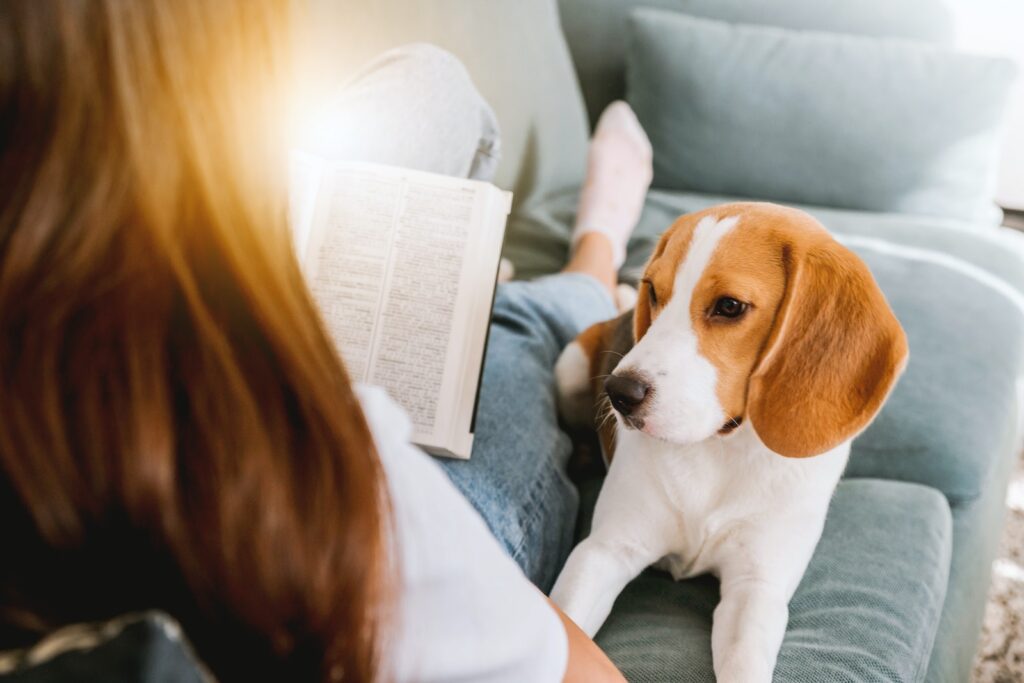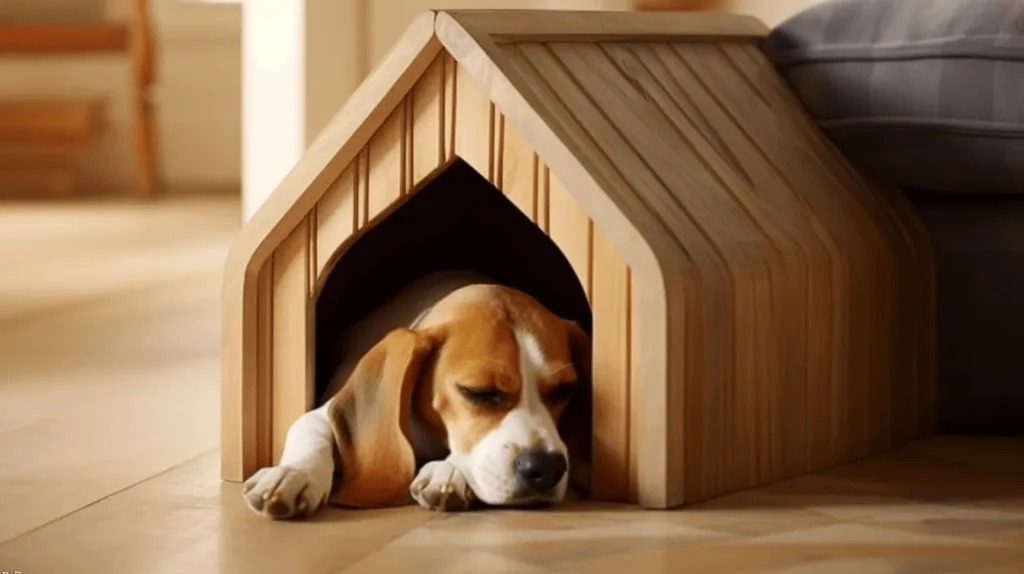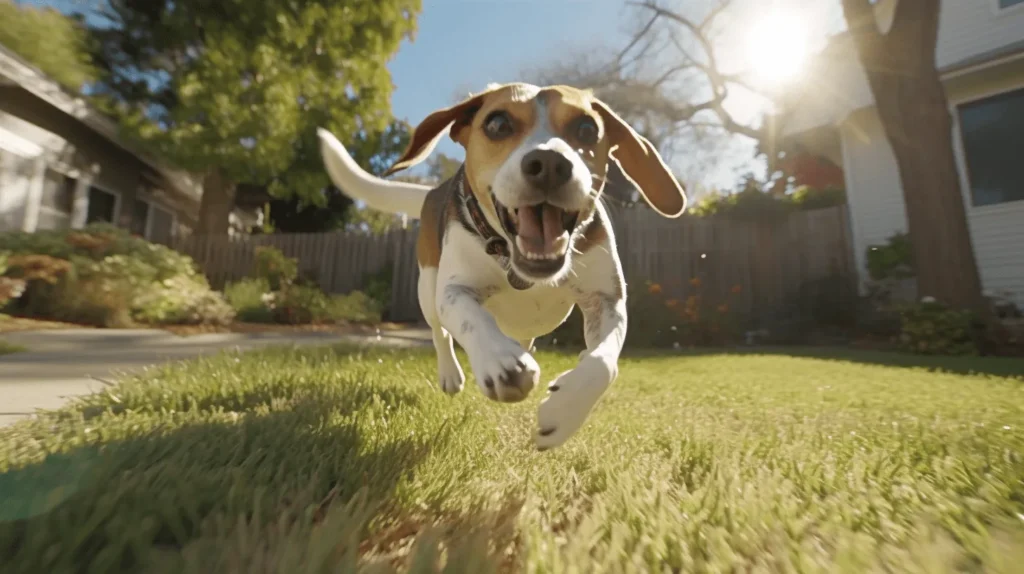Ah, the Beagle! The breed that wears its heart on its wagging tail and its nose on every scent trail. As a proud Beagle owner, I’ve often marveled at the sheer enthusiasm these dogs bring to… well, everything. But what happens when you decide to introduce your Beagle to another dog for the first time? It’s like setting up a blind date, but with more sniffing involved.
Contents
First Impressions Matter
We’ve all been there, haven’t we? That awkward moment when you’re meeting someone for the first time, and you’re not sure whether to go in for a handshake, a hug, or a casual nod. Now, imagine that scenario, but with more sniffing. Welcome to the world of doggy introductions!
The Sniff Greeting
In the human world, we have handshakes, waves, or even the occasional high-five. In the dog world? It’s all about the sniff. This isn’t just a casual “How do you do?” but rather a deep dive into who this new dog is. Think of it as scrolling through someone’s entire social media history in a matter of seconds. Impressive, right?
Setting the Stage
The environment plays a huge role in first impressions. Imagine trying to have a heart-to-heart in the middle of a rock concert. Not ideal, right? Similarly, introducing dogs in a chaotic environment can be overwhelming. A calm, neutral setting, like a quiet part of the park, can make all the difference. It’s like choosing a cozy coffee shop for a first date. Ambiance matters!
Body Language Speaks Volumes
Ever met someone who says one thing but their body screams something else? Dogs are masters of body language. A wagging tail, perked ears, or a playful bow can tell you more than any bark ever will. As the interpreter (or should I say, the dog whisperer?), you need to keep an eye out for these subtle cues. It’s like decoding a secret language, and trust me, it’s fascinating!
The Role of Humans
Yes, that’s us! We’re not just passive observers in this grand introduction. Our energy, our reactions, and even our little encouragements play a crucial role. Ever noticed how dogs often look at their owners during introductions? It’s like they’re checking in, seeking assurance. “Is this new guy cool, human?” Your calm demeanor can set the tone for the entire meeting. So, channel your inner Zen master and keep things chill.
The Follow-Up
First impressions don’t end with the first meeting. Oh no! The follow-up is just as crucial. Think of it as the text after the first date. A positive reinforcement, like a treat or a cheerful “Good boy!”, can go a long way in cementing that first impression.
Location, Location, Location
As a proud Beagle parent, I’ve come to realize that where you introduce your furry friend to another canine companion is just as crucial as the introduction itself. It’s like setting the stage for a grand play, and trust me, with Beagles, there’s always a touch of drama!
Neutral Ground: The Canine Switzerland
Imagine being introduced to someone new in your own living room. Cozy? Yes. But also a tad territorial, right? Dogs, especially our beloved Beagles, can be quite protective of their turf. So, the first meeting shouldn’t happen in your backyard or theirs. Instead, opt for neutral territory. Think of it as meeting at a coffee shop instead of someone’s home. Neutral, relaxed, and no one’s hogging the remote!
Open Spaces: Room to Roam (and Retreat)
Ever tried having a conversation in a cramped elevator? Awkward, isn’t it? Now, imagine two dogs trying to get to know each other in a tight space. Yikes! Open spaces, like a park or a large open field, offer dogs the freedom to approach, circle, sniff, and if needed, take a step back. It’s like giving them a vast canvas to paint their first impression.
Familiar Yet Unclaimed: The Sweet Spot
While neutral territory is essential, throwing your Beagle into a completely unfamiliar environment can be overwhelming. The trick? Find a spot they’ve visited before but isn’t part of their daily routine. Maybe that park you visit occasionally on weekends? It’s familiar enough to be comforting but not so routine that they’ve marked every tree as their own.
Distraction-Free Zone: Keep the Squirrels at Bay
Beagles have a nose that doesn’t quit. Introduce them in an area teeming with intriguing scents, and you might find your Beagle more interested in a squirrel’s lunch than in the new dog. Choose a location with minimal distractions. It’s like trying to chat with someone without the TV blaring in the background. Focus is key!
Safety First: Always Have an Exit Strategy
While we hope every introduction goes off without a hitch, it’s essential to be prepared. Ensure the location you choose has a safe exit route, just in case things get a little heated. It’s like knowing where the emergency exit is in a movie theater. You hope you never need it, but it’s good to know it’s there.
Leash Etiquette
Ah, the leash! That long, winding tether that keeps our furry friends close, yet often ends up tying us in knots, both literally and figuratively. As a Beagle owner, I’ve had my fair share of leash mishaps. Ever tried untangling a Beagle and a Dachshund? It’s like solving a Rubik’s Cube while riding a roller coaster. But fear not, fellow dog lovers! Mastering the art of leash etiquette is not as daunting as it sounds.
The Slack is Where It’s At
You know that feeling when someone’s breathing down your neck? Uncomfortable, right? That’s how dogs feel with a tight leash. Always ensure your leash remains slack during introductions. A relaxed leash sends a clear message to your Beagle: “All’s well, buddy!” A taut leash, on the other hand, screams tension and can make your dog more anxious or defensive. Remember, the leash is a tool, not a restraint. Think of it as a gentle guiding hand, not a tight grip.
The Right Length for the Right Time
Retractable leashes can be great for open spaces, giving your Beagle the freedom to explore. But during introductions? Not so much. You want to have more control during those crucial first sniffs. A standard 6-foot leash works wonders. It’s like the Goldilocks of leashes – not too long, not too short, just right.
Be Alert, Not Alarmed
Stay vigilant during introductions. Watch for signs of tension, but don’t be overly jumpy. Dogs pick up on our energy. If you’re calm and collected, chances are, your Beagle will be too. It’s like being the cool, collected captain of a ship. Even if there’s a storm brewing, you know how to navigate the waters.
Quick Reflexes, Calm Responses
Sometimes, despite our best efforts, things can go south. Maybe the dogs lunged at each other, or perhaps the leashes got tangled. Stay calm. Quickly and gently separate the dogs without yanking the leash. It’s like untangling headphones; the more you yank, the tighter the knot.
Practice Makes Purr-fect
Okay, I know, wrong animal metaphor, but you get the drift. Before introducing your Beagle to another dog, practice leash walking. Get your Beagle used to walking beside you with a slack leash. The more comfortable your Beagle is on the leash, the smoother the introduction will be.
Watch Those Body Languages
I’ve often found myself playing the role of a detective, deciphering the subtle cues and gestures of my four-legged friend. It’s like trying to understand Morse code, but instead of dots and dashes, we’ve got wags, woofs, and wiggles!
The Tale of the Tail
Let’s start with the most expressive part of a dog: the tail. A wagging tail? That’s the canine equivalent of a thumbs up. But wait! Not all wags are created equal. A high, stiff wag might signal alertness or even agitation, while a relaxed, side-to-side wag usually means all’s well. It’s like the difference between a nervous hand wave and a joyous high-five.
Ears: The Satellite Dishes of Emotion
Ears perked up? Your Beagle’s picked up on something interesting. Ears laid back? It could be a sign of anxiety or submission. It’s amazing how much these floppy (or pointy) appendages can convey. Think of them as the volume knobs on a radio. They tune in, turn up, or dial down based on the mood.
The Eyes Have It
They say eyes are the windows to the soul, and this holds true for our canine companions too. A direct, hard stare might be a challenge, while soft, averted eyes often signal submission or discomfort. Ever noticed your Beagle’s eyes go all round and puppy-like when they’re up to mischief? It’s their version of batting eyelashes, and boy, does it work!
Posture Speaks Louder Than Barks
A playful bow, with the front legs stretched out and the rump in the air, is an open invitation: “Come play with me!” But a stiff, upright posture? That’s your Beagle standing at attention, possibly signaling discomfort or alertness. It’s like the difference between lounging on a couch and standing at military attention.
The Subtle Signs: Licks, Yawns, and More
Sometimes, the most telling signs are the subtle ones. A quick lick of the lips might indicate nervousness. A yawn, while often just a sign of sleepiness, can also be a stress signal in certain contexts. It’s like when we fidget or tap our feet – small gestures, but they reveal a lot.
Take It Slow
In our fast-paced world, where everything happens at the speed of a tweet, slowing down might seem like a foreign concept. But when it comes to introducing your Beagle to a new furry friend, it’s the golden rule. Think of it as savoring a fine wine or enjoying a slow dance; some things just shouldn’t be rushed.
The First Sniff: A Delicate Affair
Remember your first date? The nervous anticipation, the tentative conversation starters? That’s how our Beagles feel during their first sniff. It’s their way of saying, “Hello, who might you be?” A rushed introduction can feel like being pushed into a mosh pit when you were expecting a waltz. So, let them take their time, explore, and get acquainted at their own pace.
Reading the Room (or the Park)
Just as we gauge the mood of a room when we enter, dogs too take in their surroundings. They assess the environment, the other dog’s body language, and even our own vibes. By allowing them to take it slow, we give them the space to read and react appropriately. It’s like giving them time to adjust their sails based on the wind.
Baby Steps to BFFs
Friendships, whether human or canine, don’t blossom overnight. Start with short, supervised interactions. Think of these as mini playdates. A quick romp in the park today, a shared toy session tomorrow. Gradually increase the time they spend together, always ensuring both dogs feel comfortable. It’s like building a jigsaw puzzle, one piece at a time.
The Power of Positive Reinforcement
Every positive interaction is a step closer to friendship. Reward these moments with treats, praises, or even a belly rub. It reinforces the idea that good things happen when they’re around their new friend. It’s like getting a gold star in school; it just makes you want to do better!
Know When to Hit Pause
Despite our best efforts, not every interaction will be smooth sailing. And that’s okay. If things get tense or if either dog seems overwhelmed, it’s time for a break. Think of it as pressing pause on a movie. You can always resume when things feel right.
What If They Don’t Get Along?
The age-old conundrum! It’s like setting up two friends on a blind date, only to discover they have the chemistry of oil and water. As a Beagle aficionado, I’ve been there, done that, and got the chewed-up slipper to prove it. So, what do you do when your Beagle and their potential new buddy don’t see eye to eye, or should I say, nose to tail?
Don’t Force the Friendship
Imagine being stuck in a room with someone who insists on talking about their stamp collection for hours. Torture, right? Similarly, forcing two dogs to get along can be counterproductive. If they’re not vibing, it’s okay. Not every dog will be your Beagle’s cup of tea (or bowl of kibble).
Understand the Why
Dogs, much like us, have their reasons. Maybe it’s a size difference, a territorial issue, or perhaps they just stepped on each other’s paws the wrong way. Observing their interactions can give you clues. It’s like playing detective, but with more fur and fewer magnifying glasses.
Take a Break and Regroup
If the first meeting goes south, don’t despair. Separate the dogs and give them some time to cool off. It’s like hitting the reset button. Sometimes, a little space and a change of environment can work wonders.
Seek Expert Advice
If you’re keen on making the friendship work, consider seeking advice from a dog trainer or behaviorist. They can offer insights and strategies to smooth things over. Think of them as the relationship counselors of the canine world.
Celebrate the Small Wins
So, they didn’t become best buddies on day one. That’s okay. Maybe they had a moment where they played together or shared a toy. Celebrate those moments. It’s like cheering for baby steps, knowing they’ll eventually lead to bigger strides.
Know When to Call It Quits
Despite our best efforts, some relationships just aren’t meant to be. And that’s okay. Your Beagle can still have a fulfilling life with other doggy friends or even as an ‘only child’. It’s like understanding that not every friendship is forever, and that’s perfectly fine.
Conclusion: The Paws and Reflect Moment
Introducing your Beagle to another dog is an exciting adventure. It’s like setting up two friends and hoping they hit it off. With patience, understanding, and a bit of doggy wisdom, you can pave the way for a beautiful friendship. Or at the very least, a polite nod when they pass each other in the park.
So, are you ready to play matchmaker for your Beagle? Go on, take the plunge. And when you see those tails wagging in sync, you’ll know you’ve hit the jackpot.
Feeling enlightened? Think this guide might help a fellow dog owner? Click that share button! Whether it’s Facebook, Twitter, or Pinterest, spread the Beagle love. After all, in the world of dogs, the more, the merrier. And who knows, your Beagle might just find its new best friend, thanks to you.

